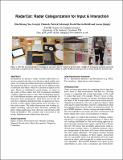Files in this item
RadarCat : Radar Categorization for input & interaction
Item metadata
| dc.contributor.author | Yeo, Hui Shyong | |
| dc.contributor.author | Flamich, Gergely | |
| dc.contributor.author | Schrempf, Patrick Maurice | |
| dc.contributor.author | Harris-Birtill, David Cameron Christopher | |
| dc.contributor.author | Quigley, Aaron John | |
| dc.date.accessioned | 2016-10-16T23:34:17Z | |
| dc.date.available | 2016-10-16T23:34:17Z | |
| dc.date.issued | 2016-10-16 | |
| dc.identifier | 245678240 | |
| dc.identifier | c267eae2-2848-4520-ac0a-db13fd9068a3 | |
| dc.identifier | 84995792510 | |
| dc.identifier | 000387605000076 | |
| dc.identifier.citation | Yeo , H S , Flamich , G , Schrempf , P M , Harris-Birtill , D C C & Quigley , A J 2016 , RadarCat : Radar Categorization for input & interaction . in Proceedings of the 29th Annual Symposium on User Interface Software and Technology (UIST '16) . ACM , pp. 833-841 , 29th ACM User Interface Software and Technology Symposium , Tokyo , Japan , 16/10/16 . https://doi.org/10.1145/2984511.2984515 | en |
| dc.identifier.citation | conference | en |
| dc.identifier.isbn | 9781450341899 | |
| dc.identifier.other | ORCID: /0000-0002-5274-6889/work/34040080 | |
| dc.identifier.other | ORCID: /0000-0002-0740-3668/work/43832018 | |
| dc.identifier.other | ORCID: /0000-0003-2484-6855/work/48516901 | |
| dc.identifier.uri | https://hdl.handle.net/10023/9672 | |
| dc.description | The research described here was supported by the University of St Andrews and the Scottish Informatics and Computer Science Alliance (SICSA). | en |
| dc.description.abstract | In RadarCat we present a small, versatile radar-based system for material and object classification which enables new forms of everyday proximate interaction with digital devices. We demonstrate that we can train and classify different types of materials and objects which we can then recognize in real time. Based on established research designs, we report on the results of three studies, first with 26 materials (including complex composite objects), next with 16 transparent materials (with different thickness and varying dyes) and finally 10 body parts from 6 participants. Both leave one-out and 10-fold cross-validation demonstrate that our approach of classification of radar signals using random forest classifier is robust and accurate. We further demonstrate four working examples including a physical object dictionary, painting and photo editing application, body shortcuts and automatic refill based on RadarCat. We conclude with a discussion of our results, limitations and outline future directions. | |
| dc.format.extent | 9 | |
| dc.format.extent | 7739493 | |
| dc.language.iso | eng | |
| dc.publisher | ACM | |
| dc.relation.ispartof | Proceedings of the 29th Annual Symposium on User Interface Software and Technology (UIST '16) | en |
| dc.subject | Context-aware interaction | en |
| dc.subject | Machine learning | en |
| dc.subject | Material classification | en |
| dc.subject | Object recognition | en |
| dc.subject | Ubiquitous computing | en |
| dc.subject | QA76 Computer software | en |
| dc.subject | T Technology | en |
| dc.subject | NDAS | en |
| dc.subject | BDC | en |
| dc.subject | R2C | en |
| dc.subject | ~DC~ | en |
| dc.subject.lcc | QA76 | en |
| dc.subject.lcc | T | en |
| dc.title | RadarCat : Radar Categorization for input & interaction | en |
| dc.type | Conference item | en |
| dc.contributor.institution | University of St Andrews. School of Computer Science | en |
| dc.identifier.doi | 10.1145/2984511.2984515 | |
| dc.date.embargoedUntil | 2016-10-16 |
This item appears in the following Collection(s)
Items in the St Andrews Research Repository are protected by copyright, with all rights reserved, unless otherwise indicated.

